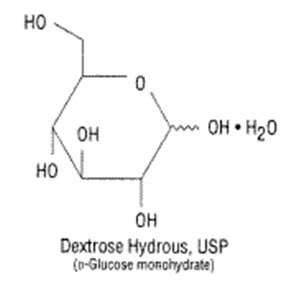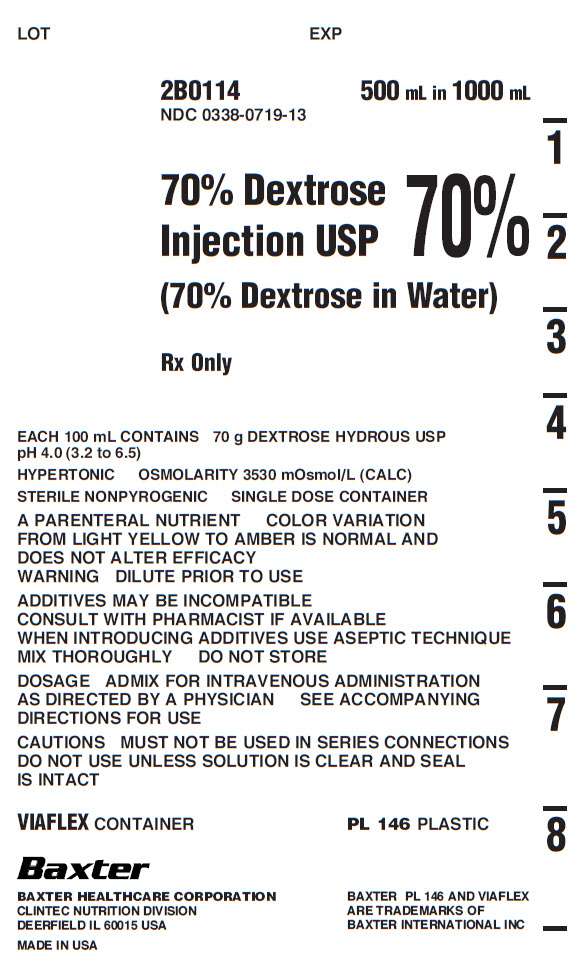Dextrose
70% Dextrose Injection, USPin VIAFLEX Plastic ContainerA Parenteral Nutrient
FULL PRESCRIBING INFORMATION: CONTENTS*
- DEXTROSE DESCRIPTION
- CLINICAL PHARMACOLOGY
- DEXTROSE INDICATIONS AND USAGE
- DEXTROSE CONTRAINDICATIONS
- WARNINGS
- PRECAUTIONS
- DEXTROSE ADVERSE REACTIONS
- DEXTROSE DOSAGE AND ADMINISTRATION
- HOW SUPPLIED
- DIRECTIONS FOR USE OF VIAFLEX PLASTIC CONTAINER
- PRINCIPAL DISPLAY PANEL - PACKAGING LABELING
FULL PRESCRIBING INFORMATION
DEXTROSE DESCRIPTION
Dextrose Injection, USP is a sterile, nonpyrogenic, hypertonic solution for fluid replenishment and caloric supply in single dose container for intravenous administration after compounding. It contains no antimicrobial agents. Composition, osmolarity, pH, and caloric content are shown in Table 1.
| Composition |
Osmolarity
|
pH |
Calo ric Content (kcal/L) |
How Supplied | |
| Dextrose Hydrous, USP (g/L) |
|||||
| Size | |||||
|
500 mL in 1000 mL container |
|||||
| Code and NDC | |||||
| 70% Dextrose Injection, USP | 700 | 3530 | 4.0 (3.2 to 6.5) |
2390 | 2B0114 NDC 0338-0719-13 |
The structural formula of Dextrose Hydrous, USP is:

The VIAFLEX plastic container is fabricated from a specially formulated polyvinyl chloride (PL 146 Plastic). Exposure to temperatures above 25ºC/77ºF during transport and storage will lead to minor losses in moisture content. Higher temperatures lead to greater losses. It is unlikely that these minor losses will lead to clinically significant changes within the expiration period. The amount of water that can permeate from inside the container into the overwrap is insufficient to affect the solution significantly. Solutions in contact with the plastic container may leach out certain chemical components from the plastic in very small amounts; however, biological testing was supportive of the safety of the plastic container materials.
CLINICAL PHARMACOLOGY
Dextrose Injections, USP have value as a source of water and calories. They are capable of inducing diuresis depending on the clinical condition of the patient.
DEXTROSE INDICATIONS AND USAGE
Dextrose Injections, USP are indicated as a caloric component in a parenteral nutrition regimen. They are used with an appropriate protein (nitrogen) source in the prevention of nitrogen loss or in the treatment of negative nitrogen balance in patients where: (1) the alimentary tract cannot or should not be used, (2) gastrointestinal absorption of protein is impaired, or (3) metabolic requirements for protein are substantially increased, as with extensive burns.
DEXTROSE CONTRAINDICATIONS
The infusion of hypertonic dextrose injections is contraindicated in patients having intracranial or intraspinal hemorrhage, in patients who are severely dehydrated, in patients who are anuric, and in patients in hepatic coma.
Solutions containing dextrose may be contraindicated in patients with known allergy to corn or corn products.
WARNINGS
Dilute before use to a concentration which will, when administered with an amino acid (nitrogen) source, result in an appropriate calorie to gram of nitrogen ratio and which has an osmolarity consistent with the route of administration.
Unless appropriately diluted, the infusion of hypertonic dextrose injection into a peripheral vein may result in vein irritation, vein damage, and thrombosis. Strongly hypertonic nutrient solutions should only be administered through an indwelling intravenous catheter with the tip located in a large central vein such as the superior vena cava.
In very low birth weight infants, excessive or rapid administration of dextrose injection may result in increased serum osmolality and possible intracerebral hemorrhage.
WARNING: This product contains aluminum that may be toxic. Aluminum may reach toxic levels with prolonged parenteral administration if kidney function is impaired. Premature neonates are particularly at risk because their kidneys are immature, and they require large amounts of calcium and phosphate solutions, which contain aluminum.
Research indicates that patients with impaired kidney function, including premature neonates, who receive parenteral levels of aluminum at greater than 4 to 5 mcg/kg/day accumulate aluminum at levels associated with central nervous system and bone toxicity. Tissue loading may occur at even lower rates of administration.
PRECAUTIONS
Do not use plastic containers in series connections. Such use could result in air embolism due to residual air being drawn from the primary container before administration of the fluid from the secondary container is completed.
Pressurizing intravenous solutions contained in flexible plastic containers to increase flow rates can result in air embolism if the residual air in the container is not fully evacuated prior to administration.
Use of a vented intravenous administration set with the vent in the open position could result in air embolism. Vented intravenous administration sets with the vent in the open position should not be used with flexible plastic containers.
Administration of hypertonic dextrose and amino acid solutions via central venous catheter may be associated with complications which can be prevented or minimized by careful attention to all aspects of the procedure. This includes attention to solution preparation, administration and patient monitoring.
It is essential that a carefully prepared protocol, based upon current medical practice, be followed, preferably by an experienced team. The package insert of the protein (nitrogen) source should be consulted for dosage and all precautionary information.
Clinical evaluation and periodic laboratory determinations are necessary to monitor changes in fluid balance, electrolyte concentrations, and acid base balance during prolonged parenteral therapy or whenever the condition of the patient warrants such evaluation.
Care should be taken to avoid circulatory overload, particularly in patients with cardiac insufficiency.
Caution must be exercised in the administration of these injections to patients receiving corticosteroids or corticotropin.
These injections should be used with caution in patients with overt or subclinical diabetes mellitus.
Drug product contains no more than 25 mcg/L of aluminum.
Carcinogenesis, Mutagenesis, Impairment of Fertility.
Studies with Dextrose Injection, USP, have not been performed to evaluate carcinogenic potential, mutagenic potential, or effects on fertility.
Pregnancy:
Teratogenic Effects
Pregnancy Category C.
Animal reproduction studies have not been conducted with Dextrose Injections, USP. It is also not known whether Dextrose Injections, USP can cause fetal harm when administered to a pregnant woman or can affect reproduction capacity. Dextrose Injections, USP should be given to a pregnant woman only if clearly needed.
Nursing Mothers:
Caution should be exercised when Dextrose Injection, USP, is administered to a nursing woman.
Pediatric Use:
Dextrose is safe and effective for the stated indications in pediatric patients (see Indications and Usage ).
Newborns – especially those born premature and with low birth weight - are at increased risk of developing hypo- or hyperglycemia and therefore need close monitoring during treatment with intravenous glucose solutions to ensure adequate glycemic control in order to avoid potential long term adverse effects. Hypoglycemia in the newborn can cause prolonged seizures, coma and brain damage. Hyperglycemia has been associated with intraventricular hemorrhage, late onset bacterial and fungal infection, retinopathy of prematurity, necrotizing enterocolitis, bronchopulmonary dysplasia, prolonged length of hospital stay, and death.
DEXTROSE ADVERSE REACTIONS
Too rapid infusion of a hypertonic dextrose solution may result in diuresis, hyperglycemia, glycosuria, and hyperosmolar coma. Continual clinical monitoring of the patient is necessary in order to identify and initiate measures for these clinical conditions.
Hypersensitivity reactions, including anaphylaxis and chills.
Reactions which may occur because of the solution or the technique of administration include febrile response, infection at the site of injection, venous thrombosis or phlebitis extending from the site of injection, extravasation and hypervolemia.
If an adverse reaction does occur, discontinue the infusion, evaluate the patient, institute appropriate therapeutic countermeasures, and save the remainder of the fluid for examination if deemed necessary.
DEXTROSE DOSAGE AND ADMINISTRATION
Following suitable admixture of prescribed drugs, the dosage is usually dependent upon the age, weight and clinical condition of the patient as well as laboratory determinations. See directions accompanying drugs. Parenteral drug products should be inspected visually for particulate matter and discoloration prior to administration whenever solution and container permit.
Do not administer unless solution is clear and seal is intact.
These admixed injections in VIAFLEX plastic containers are intended for intravenous administration using sterile equipment.
The dosage selection and constant infusion rate of intravenous dextrose must be selected with caution in pediatric patients, particularly neonates and low birth weight infants, because of the increased risk of hyperglycemia/ hypoglycemia. Frequent monitoring of serum glucose concentrations is required when dextrose is prescribed to pediatric patients, particularly neonates and low birth weight infants. The infusion rate and volume depends on the age, weight, clinical and metabolic conditions of the patient, concomitant therapy and should be determined by the consulting physician experienced in pediatric intravenous fluid therapy.
Additives may be incompatible. Complete information is not available. Those additives known to be incompatible should not be used. Consult with pharmacist, if available. If, in the informed judgement of the physician, it is deemed advisable to introduce additives, use aseptic technique. Mix thoroughly when additives have been introduced. Do not store solutions containing additives.
HOW SUPPLIED
See Table 1.
Exposure of pharmaceutical products to heat should be minimized. Avoid excessive heat. Protect from freezing. It is recommended the product be stored at room temperature (25ºC/77ºF).
DIRECTIONS FOR USE OF VIAFLEX PLASTIC CONTAINER
For Information on Risk of Air Embolism - see Precautions
Preparation for Administration
- Tear overwrap down side at slit and remove solution container. Some opacity of the plastic due to moisture absorption during the sterilization process may be observed. This is normal and does not affect the solution quality or safety. The opacity will diminish gradually. Check for minute leaks by squeezing inner bag firmly. If leaks are found, discard solution as sterility may be impaired.
- Insert transfer set into prepared solution container to be transferred. Follow directions accompanying transfer set.
- Remove protector from extended middle port of dextrose solution container and insert connector of transfer set.
- Transfer solution by gravity or by using a VIAVAC unit.
- After desired solution has been transferred, mix thoroughly and seal extension tubing of extended middle port. Cut between seal and connector of transfer set.
- Check for leaks.
- Warning: Additives may be incompatible. Supplemental medication may be added with a 19 to 22 gauge needle through the medication injection site on the dextrose solution container. Mix solution and medication thoroughly. For high density medications, such as potassium chloride, squeeze ports while ports are upright and mix thoroughly.
- Suspend container from eyelet support.
- Remove plastic protector from outlet port at bottom of container.
- Attach administration set. Refer to complete directions accompanying set.
Baxter Healthcare Corporation
Deerfield, IL 60015 USA
Printed in USA
07-19-65-534 Rev. November 2013
Baxter, PL 146, and Viaflex are trademarks of Baxter International Inc.
PRINCIPAL DISPLAY PANEL - PACKAGING LABELING

LOT EXP
2B0114 500 mL in 1000 mL
NDC 0338-0719-13
70% Dextrose
Injection USP
70%
(70%
Dextrose in Water)
Rx Only
EACH 100 mL CONTAINS 70 g DEXTROSE HYDROUS USP
pH 4.0 (3.2 to 6.5)
HYPERTONIC OSMOLARITY 3530 mOsmol/L (CALC)
STERILE NONPYROGENIC SINGLE DOSE CONTAINER
A PARENTERAL NUTRIENT COLOR VARIATION
FROM LIGHT YELLOW TO AMBER IS NORMAL AND
DOES NOT ALTER EFFICACY WARNING DILUTE PRIOR TO USE
ADDITIVES MAY BE INCOMPATIBLE
CONSULT WITH PHARMACIST IF AVAILABLE
WHEN INTRODUCING ADDITIVES USE ASEPTIC TECHNIQUE
MIX THOROUGHLY DO NOT STORE
DOSAGE ADMIX FOR INTRAVENOUS ADMINISTRATION
AS DIRECTED BY A PHYSICIAN SEE ACCOMPANYING
DIRECTIONS FOR USE
CAUTIONS MUST NOT BE USED IN SERIES CONNECTIONS
DO NOT USE UNLESS SOLUTION IS CLEAR AND SEAL
IS INTACT
VIAFLEX CONTAINER PL 146 PLASTIC
Baxter Logo
Baxter Healthcare Corporation
CLINTEC NUTRITION DIVISION
DEERFIELD IL 60015 USA
MADE IN USA
BAXTER PL 146 AND VIAFLEX
ARE TRADEMARKS OF
BAXTER INTERNATION
AL INC
1
2
3
4
5
6
7
8

2B0114 12 - 500 ML IN 1000 ML
VIAFEX CONTAINER
70% DEXTROSE INJECTION, USP
EXP
XXXXX
SECONDARY BAR CODE
(17) YYMM00 (10) XXXXX
LOT
XXXXX
PRIMARY BAR CODE
(01) 50303380719131
DextroseDextrose monohydrate INJECTION, SOLUTION
| ||||||||||||||||||||||||||||||||||||||||||||||||||||||||
DextroseDextrose monohydrate INJECTION, SOLUTION
| |||||||||||||||||||||||||||||||||||||||||||||||||||||||||||||
DextroseDextrose monohydrate INJECTION, SOLUTION
| |||||||||||||||||||||||||||||||||||||||||||||||||||||||||||||
DextroseDextrose monohydrate INJECTION, SOLUTION
| |||||||||||||||||||||||||||||||||||||||||||||||||||||||||||||
DextroseDextrose monohydrate INJECTION, SOLUTION
| |||||||||||||||||||||||||||||||||||||||||||||||||||||||||||||
DextroseDextrose monohydrate INJECTION, SOLUTION
| |||||||||||||||||||||||||||||||||||||||||||||||||||||||||||||
DextroseDextrose monohydrate INJECTION, SOLUTION
| ||||||||||||||||||||||||||||||||||||||||||||||||||||||||